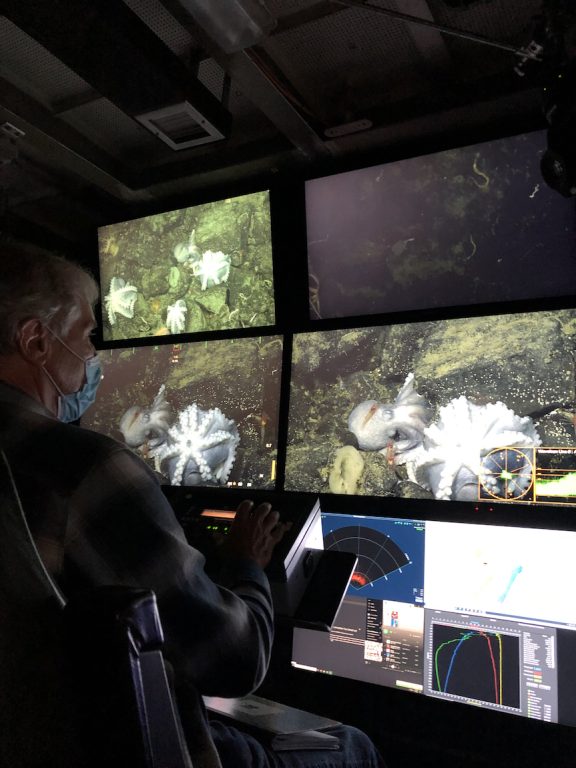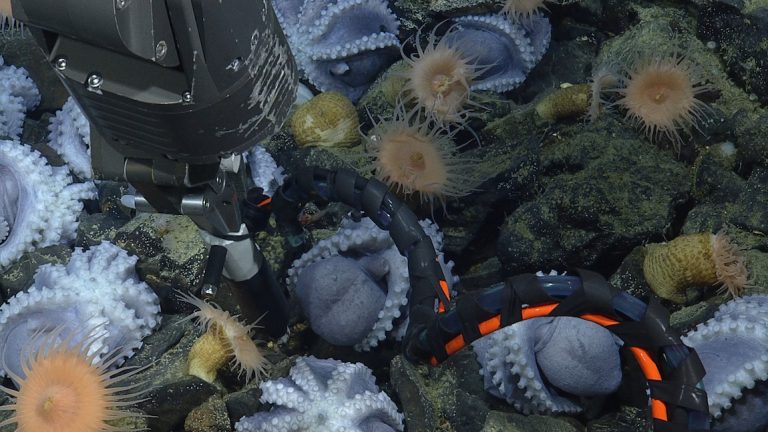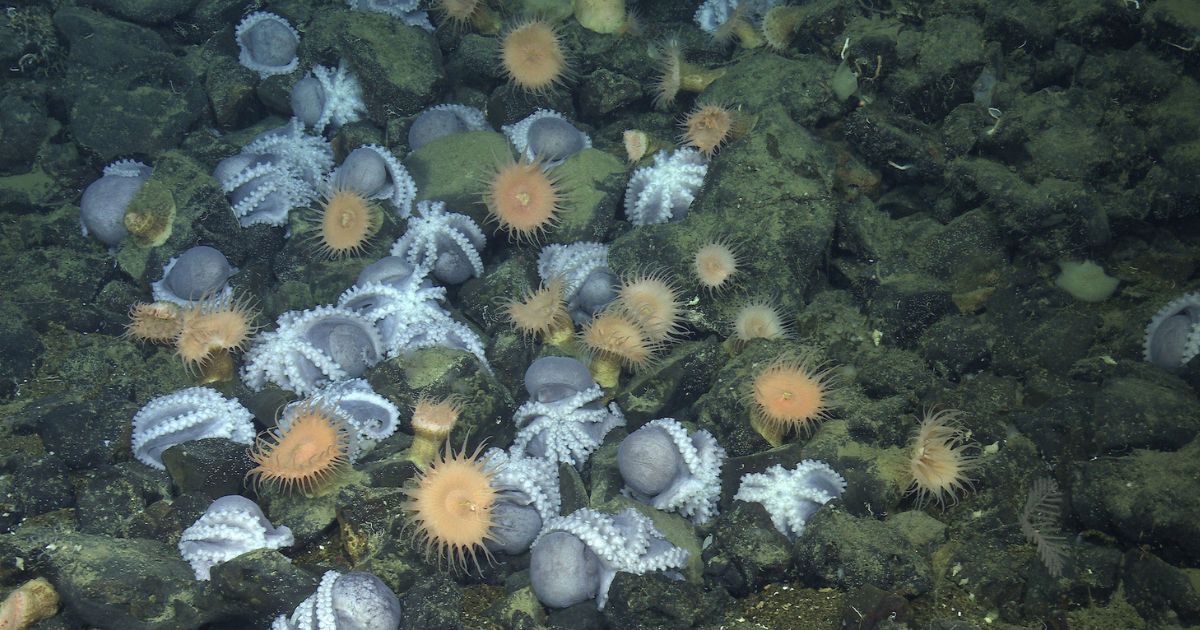In 2018, researchers from NOAA’s Monterey Bay National Marine Sanctuary and Nautilus Live observed thousands of octopus nesting on the deep seafloor off the Central California coast.
The discovery of the “Octopus Garden” captured the curiosity of millions of people around the world, including MBARI scientists. For three years, MBARI and collaborators used high-tech tools to monitor the Octopus Garden and learn exactly why this site is so attractive for deep-sea octopus.
In a new study published in Science Advances, a team of researchers from MBARI, NOAA’s Monterey Bay National Marine Sanctuary, Moss Landing Marine Laboratories, the University of Alaska Fairbanks, the University of New Hampshire, and the Field Museum confirmed that deep-sea octopus migrate to the Octopus Garden to mate and nest. The Octopus Garden is one of a handful of known deep-sea octopus nurseries. At this nursery, warmth from deep-sea thermal springs accelerates the development of octopus eggs. Scientists believe the shorter brooding period increases a hatchling octopus’ odds for survival. The Octopus Garden is the largest known aggregation of octopus on the planet—researchers counted more than 6,000 octopus in a portion of the site and expect there may be 20,000 or more at this nursery.
 A new study led by MBARI Senior Scientist Jim Barry (above) revealed that the Octopus Garden off Central California is an important octopus nursery. (Image credit: Steve Litvin, MBARI)
A new study led by MBARI Senior Scientist Jim Barry (above) revealed that the Octopus Garden off Central California is an important octopus nursery. (Image credit: Steve Litvin, MBARI)
Scientists Solve Mystery of Why Thousands of Octopus Migrate to Deep-Sea Thermal Springs. (Video credit: MBARI)
“Thanks to MBARI’s advanced marine technology and our partnership with other local researchers, we were able to observe the Octopus Garden in tremendous detail, which helped us discover why so many deep-sea octopus gather there. These findings can help us understand and protect other unique deep-sea habitats from climate impacts and other threats,” said MBARI Senior Scientist Jim Barry, lead author of the new study.
The Octopus Garden is located 3,200 meters (10,500 feet, or about two miles) below the ocean’s surface on a small hill near the base of Davidson Seamount, an extinct underwater volcano 130 kilometers (80 miles) southwest of Monterey, California. The site is full of Muusoctopus robustus—a species MBARI researchers nicknamed the pearl octopus because from a distance, nesting individuals look like opalescent pearls on the seafloor.
Over the course of 14 dives with MBARI’s remotely operated vehicle (ROV) Doc Ricketts, the research team learned why such large numbers of pearl octopus are attracted to this location. The presence of adult male and female octopus, developing eggs, and octopus hatchlings indicated that the site is used exclusively for reproduction. The team did not observe any intermediate-sized individuals or any evidence of feeding. Pearl octopus gather at this site solely to mate and nest.
 MBARI’s remotely operated vehicle (ROV) Doc Ricketts carried instruments to measure the environmental conditions within octopus nests, including temperature and oxygen levels. (Image credit: MBARI)
MBARI’s remotely operated vehicle (ROV) Doc Ricketts carried instruments to measure the environmental conditions within octopus nests, including temperature and oxygen levels. (Image credit: MBARI)
When researchers from NOAA and Nautilus Live first discovered the Octopus Garden, they observed “shimmering” waters. This phenomenon occurs when warm and cool waters mix, suggesting the region had previously unknown thermal springs. Further investigation by MBARI researchers and their collaborators confirmed octopus nests are clustered in crevices bathed by hydrothermal springs where warmer waters flow from the seafloor.
The ambient water temperature at 3,200 meters (10,500 feet) deep is 1.6 degrees Celsius (about 35 degrees Fahrenheit). However, the water temperature within the cracks and crevices at the Octopus Garden reaches nearly 11 degrees Celsius (about 51 degrees Fahrenheit).
Octopuses are ectotherms, or cold-blooded animals. The frigid temperatures of the deep sea slow their metabolism as well as their rate of embryonic development. Most deep-sea octopuses have very long incubation periods compared to their relatives inhabiting warmer shallow seas. Past experiments have measured egg incubation time for a number of octopus species in habitats and locations around the world. Comparing those egg incubation times clearly demonstrates how temperature affects the rate of embryo development—the colder the water, the slower the embryos grow.
At the near-freezing temperatures of the abyss, researchers expected pearl octopus eggs to take five to eight years, if not longer, to hatch. A 4K camera on MBARI’s ROV Doc Ricketts provided a close-up look at nesting mothers. MBARI researchers and their collaborators used the scars and other distinguishing features of individual octopus moms to monitor the development of their broods. Surprisingly, the eggs hatched in less than two years. Warmth from thermal springs increased the metabolism of female octopus and their broods, reducing the time required for incubation.
Researchers believe the shorter brood period in warmer waters greatly reduces the risk that developing octopus embryos will be injured or eaten by predators. Nesting in warmer water boosts the reproductive success of the pearl octopus, better ensuring the offspring’s survival.
“The deep sea is one of the most challenging environments on Earth, yet animals have evolved clever ways to cope with frigid temperatures, perpetual darkness, and extreme pressure. Very long brooding periods increase the likelihood that a mother’s eggs won’t survive. By nesting at hydrothermal springs, octopus moms give their offspring a leg up,” said Barry.
The massive number of octopus in one area attracts both predators and scavengers. Like most other cephalopods, pearl octopus die after they reproduce. Dead octopus at the Octopus Garden provide a feast for scavengers. A rich community of invertebrates lives alongside the nesting females, undoubtedly benefiting from unhatched eggs, vulnerable hatchlings, or adult octopus that have died.
Davidson Seamount and its Octopus Garden are protected as part of Monterey Bay National Marine Sanctuary. Previous MBARI expeditions to Davidson Seamount in 2002 and 2006 revealed the stunning community of life on its rocky slopes. MBARI’s images and video of beautiful deep-sea corals, vibrant sponges, and curious fishes engaged and inspired audiences worldwide. Ocean champions spoke up to protect this unique, and still untouched, ocean wilderness. In 2008, resource managers expanded the Monterey Bay National Marine Sanctuary to include Davidson Seamount.
“Essential biological hotspots like this deep-sea nursery need to be protected,” said Barry. “Climate change, fishing, and mining threaten the deep sea. Protecting the unique environments where deep-sea animals gather to feed or reproduce is critical, and MBARI’s research is providing the information that resource managers need for decision-making.”
This work is funded as part of the David and Lucile Packard Foundation’s long-term support of MBARI’s ocean research and technology.



